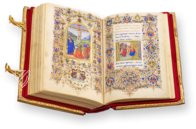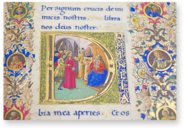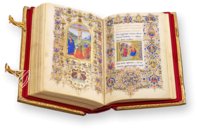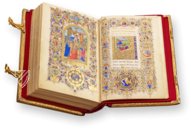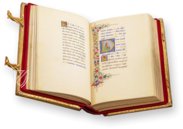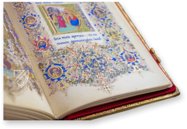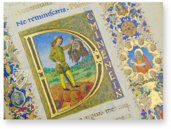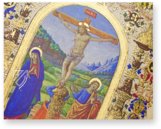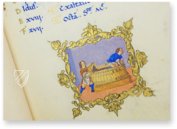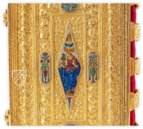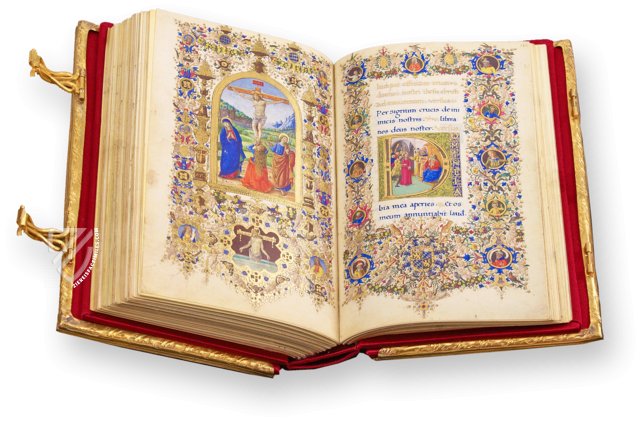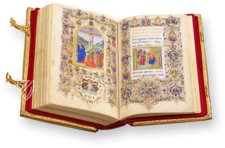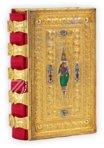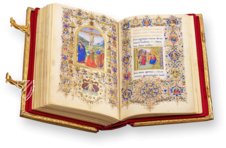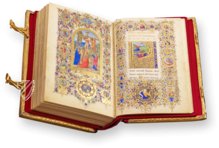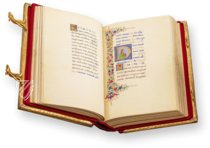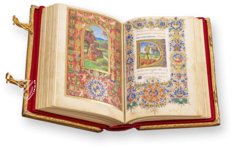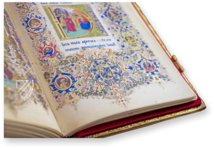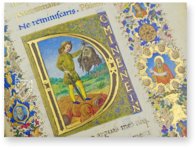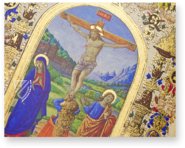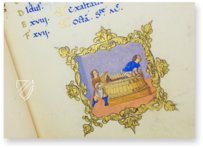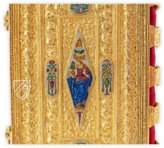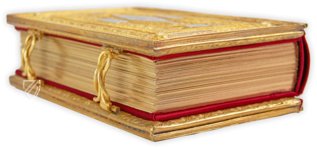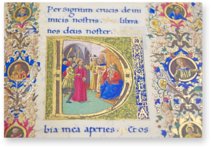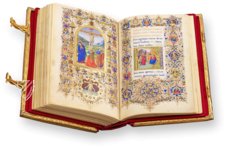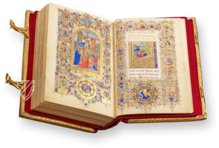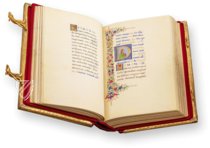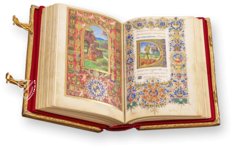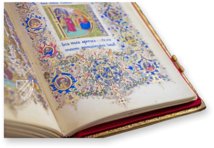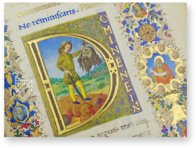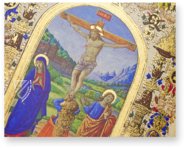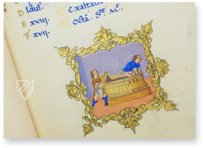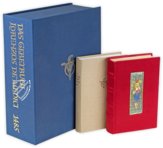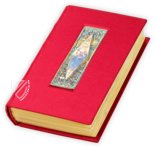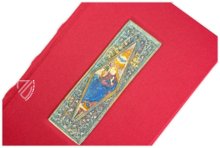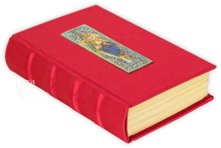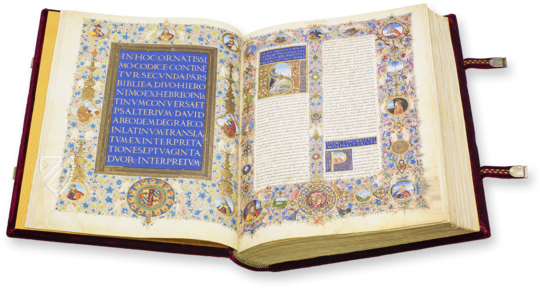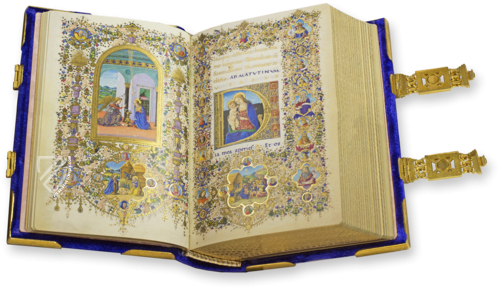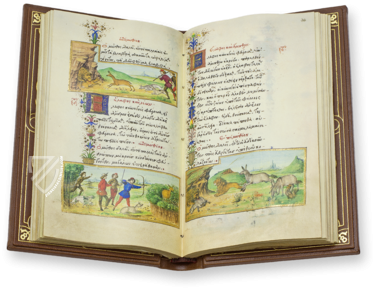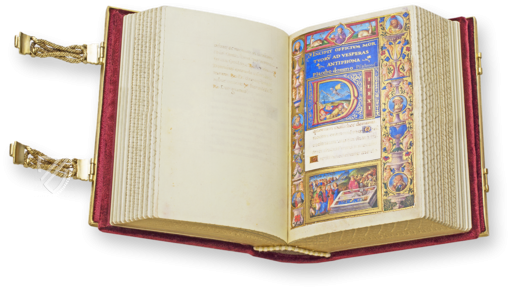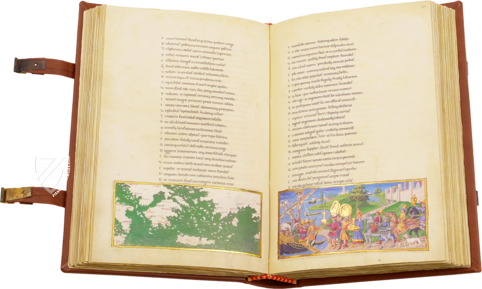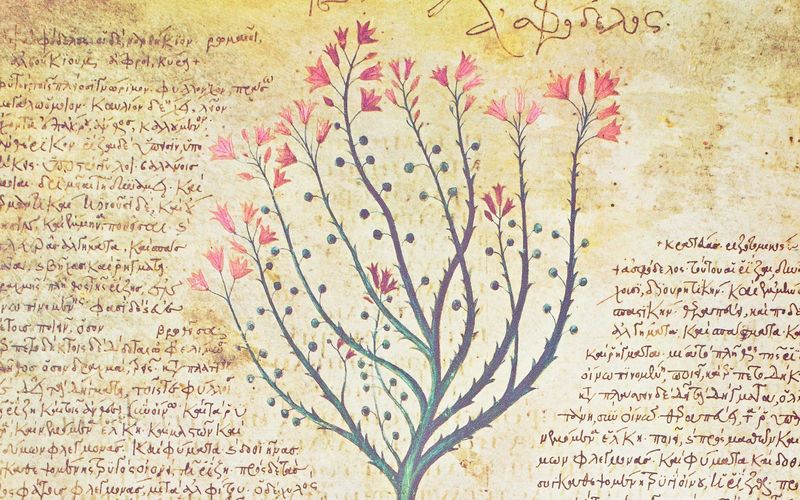Prayer Book of Lorenzo de' Medici
(3,000€ - 7,000€)
The splendid Prayer Book of Lorenzo de' Medici (1449–1492) was a wedding present to his eldest daughter Lucrezia (1470–1553), who married the Florentine banker Jacopo Salviati (1461–1533). The gilded silver binding with finely worked enamel reveals directly to the beholder what a precious manuscript this is. Hidden within it are 556 pages with ten magnificent full-page miniatures, twelve elaborate calendar medallions, and seven large historiated initials surrounded by exuberant, golden borders. Partially in gold and brilliant blue ink, the pious prayer texts were written on the parchment by the talented scribe Antonio Sinibaldi (1443 – before 1528), while the splendid imagery is the work of Francesco Rosselli (1455–1513), a miniature painter favored by the Medicis, who thus created a truly sumptuous Renaissance masterpiece.
Prayer Book of Lorenzo de' Medici
Lorenzo de’ Medici (1449–1492) earned the epithet of “the Magnificent” thanks to his generous patronage of the fine arts. Consistent with his love of painting, he gifted a splendid prayer book to his older daughter Lucrezia (1470–1553) on the occasion of her wedding to the Florentine banker Jacopo Salviati (1461–1533). The manuscript originated in 1485 with ten full-page miniatures, twelve smaller calendar medallions and seven historiated initials on a total of 556 pages. The party responsible for the detailed paintings was the Medici family’s most favored miniaturist, Francesco Rosselli (1455–1513), the younger brother of the famous Florentine painter Cosimo Rosselli (1439–1507). Antonio Sinibaldi (1443-before 1528) contributed to the work as a scribe. He worked primarily for wealthy collectors and occasionally in permanent positions, such as for King Ferrante of Naples (1424–1494).
Gleaming Binding
The beholder is made aware of the preciousness of the manuscript even before they lay eyes on its luminous miniatures. A radiant gilded silver binding houses the prayer book. The silver plates of both covers are interlinked by five hinges decorated with vegetal décor. The richly ornamented front cover displays a diamond-shaped enamel work in the center field with the Archangel Gabriel, while Mary can be seen on the back cover. The binding alone demonstrates that this is an exceptionally precious manuscript.
A Recognizable Pattern of Décor
The painter Francesco Rosselli showed particular discipline in designing individual pages with an architectural pattern of décor. While large primary scenes such as the Annunciation or the Crucifixion are encompassed in arched frames, appearing underneath them are smaller pictures in quatrefoil or multi-foil frames. The entire composition was then encompassed by repetitively detailed decorative motifs such as foliage, diamond rings, or winged cherubs. Thus, the impression is given that every page is decorated down to the smallest detail, making it possible to continuously discover something new.
Codicology
- Alternative Titles
- Gebetbuch des Lorenzo de' Medici
- Size / Format
- 556 pages / 17.0 × 10.8 cm
- Origin
- Italy
- Date
- 1485
- Epochs
- Style
- Genre
- Language
- Illustrations
- 10 full-page miniatures, 12 smaller calendar miniatures, 7 historiated initials
- Patron
- Wedding present from Lorenzo de' Medici (1449–1492) to his eldest daughter, Lucrezia, and Jacopo Salviati (1488)
- Artist / School
- Francesco Rosselli (1455–1513) (illuminator)
Antonio Sinibaldi (1443 – before 1528) (scribe) - Previous Owners
- The manuscript was perhaps a gift to the dukes of Wittelsbach in whose inventory it appears for the first time in 1598. In 1785 it passed into the possessions of the Court Library in Munich.
Prayer Book of Lorenzo de' Medici
November: Plowing Fields
The medallion miniature for this calendar page shows a typical labor of the month, but like many agricultural activities, the scene depended upon where the manuscript originated. Most illuminated calendar pages show a scene of plowing or sowing winter rye in October, but because this manuscript is from sunny Italy, this activity is pushed back a month. A farmer is shown driving two oxen with a background of barren trees and distant Alpine peaks inside of a splendid gold leaf frame.
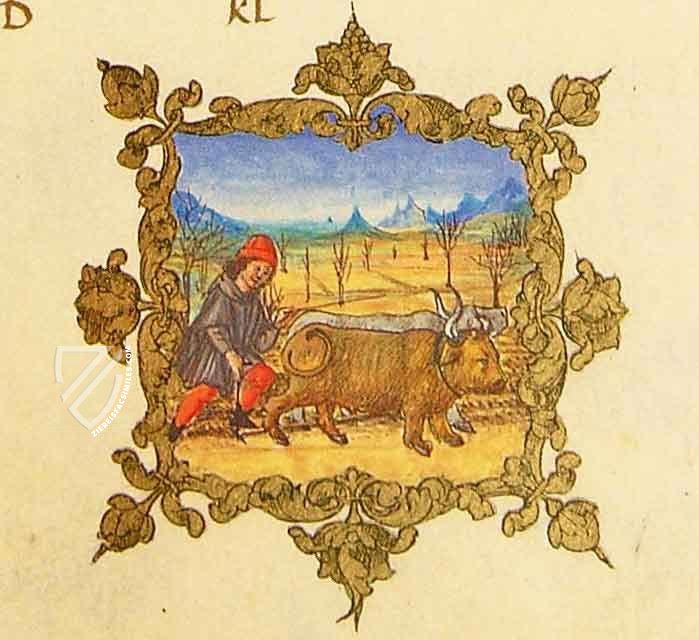
Prayer Book of Lorenzo de' Medici
Front Cover and Spine
This elaborate book cover consists of five colorful enamel inlays set in gilded silver over a wood binding, which is engraved with roses, acanthus leaves, ribbons, and braided cords. The underlying silver is showing through the gold in some places, indicating that this was indeed a personal devotional manuscript that was frequently used. It was created by an unknown goldsmith ca. 1485.
The central enamel features the archangel Gabriel (the Virgin Mary is on the back), surrounded by four other enamels with flowers in amphorae, tendrils, and a bird. Five hinges, also made of gilded silver, connect the nearly identical front and back covers and consist of symmetrically arranged palmettes flanking a blossom surrounded by petals in the center.
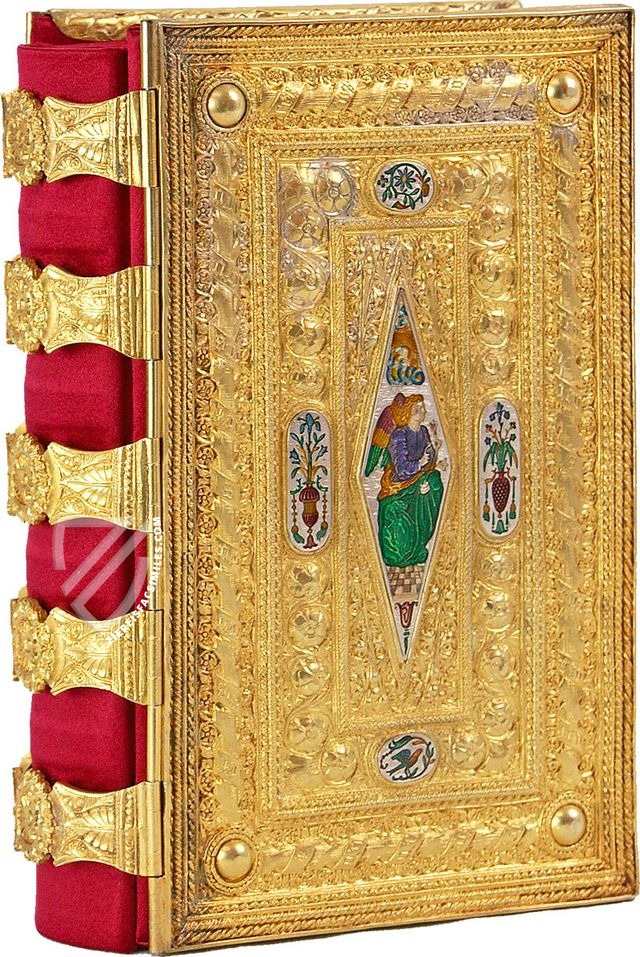
#1 Gebetbuch des Lorenzo de' Medici - De Luxe Edition
Languages: German
(3,000€ - 7,000€)
#2 Gebetbuch des Lorenzo de' Medici - Standard Edition
Languages: German
(1,000€ - 3,000€)
- Treatises / Secular Books
- Apocalypses / Beatus
- Astronomy / Astrology
- Bestiaries
- Bibles / Gospels
- Chronicles / History / Law
- Geography / Maps
- Saints' Lives
- Islam / Oriental
- Judaism / Hebrew
- Single Leaf Collections
- Leonardo da Vinci
- Literature / Poetry
- Liturgical Manuscripts
- Medicine / Botany / Alchemy
- Music
- Mythology / Prophecies
- Psalters
- Other Religious Books
- Games / Hunting
- Private Devotion Books
- Other Genres
- Afghanistan
- Armenia
- Austria
- Belgium
- Belize
- Bosnia and Herzegovina
- China
- Colombia
- Costa Rica
- Croatia
- Cyprus
- Czech Republic
- Denmark
- Egypt
- El Salvador
- Ethiopia
- France
- Germany
- Greece
- Guatemala
- Honduras
- Hungary
- India
- Iran
- Iraq
- Israel
- Italy
- Japan
- Jordan
- Kazakhstan
- Kyrgyzstan
- Lebanon
- Liechtenstein
- Luxembourg
- Mexico
- Morocco
- Netherlands
- Palestine
- Panama
- Peru
- Poland
- Portugal
- Romania
- Russia
- Serbia
- Spain
- Sri Lanka
- Sweden
- Switzerland
- Syria
- Tajikistan
- Turkey
- Turkmenistan
- Ukraine
- United Kingdom
- United States
- Uzbekistan
- Vatican City
- A. Oosthoek, van Holkema & Warendorf
- Aboca Museum
- Ajuntament de Valencia
- Akademie Verlag
- Akademische Druck- u. Verlagsanstalt (ADEVA)
- Aldo Ausilio Editore - Bottega d’Erasmo
- Alecto Historical Editions
- Alkuin Verlag
- Almqvist & Wiksell
- Amilcare Pizzi
- Andreas & Andreas Verlagsbuchhandlung
- Archa 90
- Archiv Verlag
- Archivi Edizioni
- Arnold Verlag
- ARS
- Ars Magna
- ArtCodex
- AyN Ediciones
- Azimuth Editions
- Badenia Verlag
- Bärenreiter-Verlag
- Belser Verlag
- Belser Verlag / WK Wertkontor
- Benziger Verlag
- Bernardinum Wydawnictwo
- BiblioGemma
- Biblioteca Apostolica Vaticana (Vaticanstadt, Vaticanstadt)
- Bibliotheca Palatina Faksimile Verlag
- Bibliotheca Rara
- Boydell & Brewer
- Bramante Edizioni
- Bredius Genootschap
- Brepols Publishers
- British Library
- C. Weckesser
- Caixa Catalunya
- Canesi
- CAPSA, Ars Scriptoria
- Caratzas Brothers, Publishers
- Carus Verlag
- Casamassima Libri
- Centrum Cartographie Verlag GmbH
- Chavane Verlag
- Christian Brandstätter Verlag
- Circulo Cientifico
- Club Bibliófilo Versol
- Club du Livre
- CM Editores
- Collegium Graphicum
- Collezione Apocrifa Da Vinci
- Comissão Nacional para as Comemorações dos Descobrimentos Portugueses
- Coron Verlag
- Corvina
- CTHS
- D. S. Brewer
- Damon
- De Agostini/UTET
- De Nederlandsche Boekhandel
- De Schutter
- Deuschle & Stemmle
- Deutscher Verlag für Kunstwissenschaft
- DIAMM
- Droz
- E. Schreiber Graphische Kunstanstalten
- Ediciones Boreal
- Ediciones Grial
- Ediclube
- Edições Inapa
- Edilan
- Editalia
- Edition Deuschle
- Edition Georg Popp
- Edition Leipzig
- Edition Libri Illustri
- Editiones Reales Sitios S. L.
- Éditions de l'Oiseau Lyre
- Editions Medicina Rara
- Editorial Casariego
- Editorial Mintzoa
- Editrice Antenore
- Editrice Velar
- Edizioni Edison
- Egeria, S.L.
- Eikon Editores
- Electa
- Emery Walker Limited
- Enciclopèdia Catalana
- Eos-Verlag
- Ephesus Publishing
- Ernst Battenberg
- Eugrammia Press
- Extraordinary Editions
- Fackelverlag
- Facsimila Art & Edition
- Facsimile Editions Ltd.
- Facsimilia Art & Edition Ebert KG
- Faksimile Verlag
- Feuermann Verlag
- Folger Shakespeare Library
- Franco Cosimo Panini Editore
- Friedrich Wittig Verlag
- Fundación Hullera Vasco-Leonesa
- G. Braziller
- Gabriele Mazzotta Editore
- Gebr. Mann Verlag
- Gesellschaft für graphische Industrie
- Getty Research Institute
- Giovanni Domenico de Rossi
- Giunti Editore
- Graffiti
- Grafica European Center of Fine Arts
- Guido Pressler
- Guillermo Blazquez
- Gustav Kiepenheuer
- H. N. Abrams
- Harrassowitz
- Harvard University Press
- Helikon
- Hendrickson Publishers
- Henning Oppermann
- Herder Verlag
- Hes & De Graaf Publishers
- Hoepli
- Holbein-Verlag
- Houghton Library
- Hugo Schmidt Verlag
- Idion Verlag
- Il Bulino, edizioni d'arte
- ILte
- Imago
- Insel Verlag
- Insel-Verlag Anton Kippenberger
- Instituto de Estudios Altoaragoneses
- Instituto Nacional de Antropología e Historia
- Introligatornia Budnik Jerzy
- Istituto dell'Enciclopedia Italiana - Treccani
- Istituto Ellenico di Studi Bizantini e Postbizantini
- Istituto Geografico De Agostini
- Istituto Poligrafico e Zecca dello Stato
- Italarte Art Establishments
- Jan Thorbecke Verlag
- Johnson Reprint Corporation
- Josef Stocker
- Josef Stocker-Schmid
- Jugoslavija
- Karl W. Hiersemann
- Kasper Straube
- Kaydeda Ediciones
- Kindler Verlag / Coron Verlag
- Kodansha International Ltd.
- Konrad Kölbl Verlag
- Kurt Wolff Verlag
- La Liberia dello Stato
- La Linea Editrice
- La Meta Editore
- Lambert Schneider
- Landeskreditbank Baden-Württemberg
- Leo S. Olschki
- Les Incunables
- Liber Artis
- Library of Congress
- Libreria Musicale Italiana
- Lichtdruck
- Lito Immagine Editore
- Lumen Artis
- Lund Humphries
- M. Moleiro Editor
- Maison des Sciences de l'homme et de la société de Poitiers
- Manuscriptum
- Martinus Nijhoff
- Maruzen-Yushodo Co. Ltd.
- MASA
- Massada Publishers
- McGraw-Hill
- Metropolitan Museum of Art
- Militos
- Millennium Liber
- Müller & Schindler
- Nahar - Stavit
- Nahar and Steimatzky
- National Library of Wales
- Neri Pozza
- Nova Charta
- Oceanum Verlag
- Odeon
- Orbis Mediaevalis
- Orbis Pictus
- Österreichische Staatsdruckerei
- Oxford University Press
- Pageant Books
- Parzellers Buchverlag
- Patrimonio Ediciones
- Pattloch Verlag
- PIAF
- Pieper Verlag
- Plon-Nourrit et cie
- Poligrafiche Bolis
- Presses Universitaires de Strasbourg
- Prestel Verlag
- Princeton University Press
- Prisma Verlag
- Priuli & Verlucca, editori
- Pro Sport Verlag
- Propyläen Verlag
- Pytheas Books
- Quaternio Verlag Luzern
- Reales Sitios
- Recht-Verlag
- Reichert Verlag
- Reichsdruckerei
- Reprint Verlag
- Riehn & Reusch
- Roberto Vattori Editore
- Rosenkilde and Bagger
- Roxburghe Club
- Salerno Editrice
- Saltellus Press
- Sandoz
- Sarajevo Svjetlost
- Schöck ArtPrint Kft.
- Schulsinger Brothers
- Scolar Press
- Scrinium
- Scripta Maneant
- Scriptorium
- Shazar
- Siloé, arte y bibliofilia
- SISMEL - Edizioni del Galluzzo
- Sociedad Mexicana de Antropología
- Société des Bibliophiles & Iconophiles de Belgique
- Soncin Publishing
- Sorli Ediciones
- Stainer and Bell
- Studer
- Styria Verlag
- Sumptibus Pragopress
- Szegedi Tudomànyegyetem
- Taberna Libraria
- Tarshish Books
- Taschen
- Tempus Libri
- Testimonio Compañía Editorial
- Thames and Hudson
- The Clear Vue Publishing Partnership Limited
- The Facsimile Codex
- The Folio Society
- The Marquess of Normanby
- The Richard III and Yorkist History Trust
- Tip.Le.Co
- TouchArt
- TREC Publishing House
- TRI Publishing Co.
- Trident Editore
- Tuliba Collection
- Typis Regiae Officinae Polygraphicae
- Union Verlag Berlin
- Universidad de Granada
- University of California Press
- University of Chicago Press
- Urs Graf
- Vallecchi
- Van Wijnen
- VCH, Acta Humaniora
- VDI Verlag
- VEB Deutscher Verlag für Musik
- Verlag Anton Pustet / Andreas Verlag
- Verlag Bibliophile Drucke Josef Stocker
- Verlag der Münchner Drucke
- Verlag für Regionalgeschichte
- Verlag Styria
- Vicent Garcia Editores
- W. Turnowski Ltd.
- W. Turnowsky
- Waanders Printers
- Wiener Mechitharisten-Congregation (Wien, Österreich)
- Wissenschaftliche Buchgesellschaft
- Wissenschaftliche Verlagsgesellschaft
- Wydawnictwo Dolnoslaskie
- Xuntanza Editorial
- Zakład Narodowy
- Zollikofer AG




